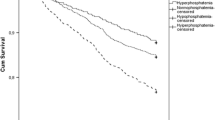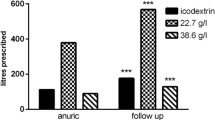Abstract
The aim of studies was a comparison of dialysisadequacy, nutritional parameters, results ofthe peritoneal equilibration test (PET) andselected standard clinical and laboratory datain peritoneal dialysis (PD) patients withdifferent age, but comparable PD duration andoutcome. Two groups of patients were examined:group I (n = 21, 9 F, 12 M) – age 67.7 ±4.5 yrs, PD duration 20.1 ± 12.1 months;group II (n = 21, 9 F, 12 M) – age 42.8 ±9.1 yrs, PD duration 20.7 ± 12.1 months.Parameters of PD adequacy, results of PET,markers of nutrition and standard laboratorymeasures were determined every 3 months to theend of PD treatment. First obtained values,mean values representing the entire PD courseand last values obtained before the end of PDtherapy were compared in group I and II.Differences in results obtained at thebeginning and at the end of PD therapy werealso compared in each group. At the beginningof PD therapy the older patients showed highertotal fat mass (TFM) expressed as % of totalbody mass (TBM), lower lean body mass (LBM),lower serum levels of iron, phosphorus andcreatinine as well as lower transferrinsaturation. When mean values representing theentire PD course were compared, the olderpatients showed higher TFM as % of TBM andserum ferritin level, whereas lower values wereobserved for diastolic blood pressure (DBP),LBM, serum creatinine, phosphorus and iron. Atthe end of PD therapy TFM as % of TBM and serumferritin level remained higher in olderpatients as well as lower both DBP and LBM weremaintained. Additionally, serum cholesterollevel and residual renal function (RRF) becameat the end of PD treatment higher in the olderindividuals compared to the younger ones. Thedifference in RRF between the two groups wascaused by the decline in RRF in the youngerpatients with relatively stable values of RRFin the older ones. Nutritional parametersimproved in the course of PD only in theyounger group. In conclusion, the olderpatients reach similar PD outcome parameterscompared to the younger ones while they showhigher TFM as % of TBM, stable RRF and moresatisfactory DBP. However, elderly patientsshow a greater progress in the deterioration ofindices of both inflammation andatherosclerosis and therefore are not able toimprove nutritional parameters.
Similar content being viewed by others
References
United States Renal Data System. USRDS 1999 Annual Data Report. Bethesda, MD: National Institutes of Health, National Institutes of Diabetes Digestive and Kidney Disease, April 1999.
Nissenson AR, Diaz-Buxo JA, Adcock A, Nelms M. Peritoneal dialysis in the geriatric patients. Am J Kidney Dis 1990; 16: 335–338.
Vlachojannis J, Kerry P, Hoppe D. CAPD in elderly patients with cardiovascular risk factors. Clin Nephrol 1988; 30(suppl 1): S13–S17.
Beak MY, Kwon TH, Kim YL, Cho DK. CAPD, an acceptable form of therapy in elderly ESRD patients: a comparative study. Adv Perit Dial 1997; 13: 158–161.
Rottembourg J. Residual renal function and recovery of renal function in patients treated by CAPD. Kidney Int 1993; 43(suppl 40): S106–S110.
Holley JL, Bernardini J, Perlmutter JA, Piraino B. A comparison of infection rates among older and younger patients on continuous peritoneal dialysis. Perit Dial Int 1994; 14: 66–69.
Bargman JM. Complications of peritoneal dialysis related to increased intra-abdominal pressure. Kidney Int 1993; 43(suppl 40): S75–S80.
Hung KY, Hsu WA, Tsai TJ et al. Continuous ambulatory peritoneal dialysis in the elderly: a seven-up experience. Postgrad Med J 1995; 71: 160–162.
Byrne C, Vernon P, Cohen JJ. Effect of age and diagnosis on survival of old patients beginning chronic dialysis. JAMA 1994; 271: 34–36.
Grzegorzewska AE, Sucharzewska-Tomczak M. Recovery of renal function in patients treated with continuous ambulatory peritoneal dialysis (CAPD) - a presentation of two cases (Polish). Nefrol Dial Pol 1998; 2: 249–251.
Davies SJ, Russell L, Bryan J et al. Comorbidity, urea kinetics, and appetite in continuous ambulatory peritoneal dialysis patients: their interrelationship and prediction of survival. Am J Kidney Dis 1995; 26: 353–361.
Grzegorzewska AE, Mariak I, Dobrowolska-Zachwieja A, Szajdak L. Effects of amino acid dialysis solution on the nutrition of continuous ambulatory peritoneal dialysis patients. Perit Dial Int 1999; 19: 462–470.
Grzegorzewska AE, Chmurak A, Dobrowolska-Zachwieja A. Nutrition of uremic patients in the course of CAPD treatment. Adv Perit Dial 1996; 12: 293–297.
Keshaviah PR, Nolph KD, Prowant B et al. Defining adequacy of CAPD with urea kinetics. Adv Perit Dial 1990; 6: 173–177.
DuBois D, DuBois EF. A formula to estimate the approximate surface area if height and weight be known. Arch Inter Med 1916; 17: 863–871.
Twardowski ZJ, Nolph KD, Khanna R et al. Peritoneal equilibration test. Perit Dial Bull 1987; 7: 138–147.
Kokot F. Obesity (in Polish). In: Orłowski T, ed. Nauka o chorobach wewnętrznych. Warszawa: PZWL, 1989; 4: 243–269.
Durnin JVGA, Womersley J. Body fat assessed from total body density and its estimation from skinfold thickness: measurements on 481 men and women aged from 16-72 years. Br J Nutr 1974; 32: 77–97.
Watson PE, Watson ID, Batt RD. Total body water volumes for adult males and females from simple anthropometric measurements. J Clin Nutr 1980; 33: 27–39.
Jankiewicz M. Zestaw do oznaczania zawartości azotu w materiale biologicznym zmodyfikowaną a metodą Kjeldahla. Rocz Wyższej Szkoły Rolniczej 1962; 13: 291–298.
Kopple JD, Blumenkrantz MJ, Jones MR et al. Plasma amino acid levels and amino acid losses during continuous ambulatory peritoneal dialysis. Am J Clin Nutr 1982; 36: 395–402.
Sargent J, Gotch F, Borah M et al. Urea kinetics, a guide to nutritional management of renal failure. Am J Clin Nutr 1978; 31: 1606–1702.
Issad B, Benevent D, Allounache M et al. 213 elderly uremic patients over 75 years of age treated with long-term peritoneal dialysis: a French multicenter study. Perit Dial Int 1996; 16(suppl 1): S414–S418.
Papagni S, Mongelli N, Gallo MA, Sasso F. Nutritional status and erythropoietin treatment in elderly patients on RDT. Abstr. XXXVII Congr. ERA-EDTA, Nice, 17-20.09.2000: 237.
Kostič S, Stojanovič M, Veličkovič-Radovanovič R et al. Adequate dialysis and nutritive status in older age patients on hemodialysis. Abstr. P14. 6th Int Conf Geriatric Nephrol Urol. Lisbon, 18-21.03.2001: 93.
Dimkovic N, Oreopoulos DG. Chronic peritoneal dialysis in the elderly: a review. Perit Dial Int2000; 20: 276–283.
Morgado E, Delgado I, Ramos A et al. Therapeutic compliance in chronic hemodialysis (CHD) elderly patients. Abstr. C30. 6th Int Conf Geriatric Nephrol Urol. Lisbon, 18-21.03.2001: 56.
Afthentopoulos IE, Oreopoulos DG. Is CAPD an effective treatment for ESRD patients with weight over 80 kg? Clin Nephrol 1997; 47: 389–393.
Johnson DW, Herzig KA, Purdie DM et al. Is obesity a favorable prognostic factor in peritoneal dialysis patients? Perit Dial Int 2000; 20: 715–721.
Don BR, Kaysen GA. Assessment of inflammation and nutrition in patients with end-stage renal disease. J Nephrol 2000; 13: 249–259.
Grzegorzewska AE, Mariak I, Leander M. Peritoneal dialysis adequacy and nutrition - relationships and outcome. In: Lee HB, Wañkowicz Z, Weryñski A, eds. 1st Korean-Polish Seminar on Theoretical, Technical and Clinical Aspects of Renal Replacement Therapy [55th International Centre of Biocybernetics Seminar (ICB)], Warszawa, 18-20.05.2000. Lecture Notes of the ICB Seminar, Vol. 49. Warszawa, 2000: 103–115.
Westlie L, Umen A, Nestrud S, Kjellstrand C. Mortality, morbidity, and life satisfaction in the very old dialysis patients. Trans ASAIO 1984; 30: 21–30.
Stenvinkel P, Heimbürger O, Paultre F et al. Strong association between malnutrition, inflammation, and atherosclerosis in chronic renal failure. Kidney Int 1999; 55: 1899–1911.
Veličkovič-Radovanovič R, Avramovič M, Raičevič R et al. Lipid abnormalities as risk factors for cardiovascular disease in older CAPD patients. Abstr. P31. 6th Int Conf Geriatric Nephrol Urol. Lisbon, 18-21.03.2001: 110.
Grzegorzewska AE, Mariak I, Dobrowolska-Zachwieja A. Differences in assessment of patients with satisfactory or complicated continuous ambulatory peritoneal dialysis courses. Adv Perit Dial 1999; 15: 116–120.
Piraino B. Recommendations for dietary protein intake in CAPD patients. Adv Perit Dial 1996; 12: 275–279.
Foley RN, Parfrey PS, Harnett JD et al. Mode of dialysis therapy and mortality in end-stage renal disease. J Am Soc Nephrol 1998; 9: 267–276.
Avram MM, Sreedhara R, Mittman N. Long-term survival in end-stage renal disease. Dial Transplant 1998; 27: 11–24.
Aslam N, Bernardini J, Johnston JR et al. Patients who improve residual renal function (GFR) after starting peritoneal dialysis (PD). Abstr. Perit Dial Int 2001; 21(suppl 1): S22.
Rottembourg J, Issad B, Allouache M, Jacobs C. Recovery of renal function in patients treated by CAPD. Adv Perit Dial 1989; 5: 63–66.
Lindblad AS, Nolph KD. Recovery of renal function in continuous ambulatory peritoneal dialysis. A study of National CAPD Registry data. Perit Dial Int 1992; 12: 43–47.
Bergström J. Appettite in CAPD patients. Perit Dial Int 1996; 16(suppl 1): S181–S184.
Churchill DN, Taylor DW, Keshaviah PR and the CANUSA Peritoneal Dialysis Study Group. Adequacy of dialysis and nutrition in continuous peritoneal dialysis: association with clinical outcomes. J Am Soc Nephrol 1996; 7: 198–207.
Locatelli F, Bommer J, London GM et al. Cardiovascular disease determinants in chronic renal failure: clinical approach and treatment. Nephrol Dial Transplant 2001; 16: 459–468.
Zager PG, Nikolic J, Brown RH et al. “U” curve association of blood pressure and mortality in hemodialysis patients. Kidney Int 1998; 54: 561–569.
Fletcher AE, Beevers DG, Bulpitt CJ et al. The relationship between a low treated blood pressure and IHD mortality: a report from the DHSS Hypertension Care Computing Project (DHCCP). J Hum Hypertens 1988; 2: 11–15.
Franklin SS, Gustin W 4th, Wong ND et al. Hemodynamic patterns of age-related changes in blood pressure. The Fram-ingham Heart Study. Circulation 1997; 96: 308–315.
Alvarez S, Locatelli A, Gomez M et al. Patients over 60 years old on peritoneal dialysis (PD). Abstr. Perit Dial Int 2000; 20: 104.
Nakamoto H, Suzuki H. Low serum albumin in elderly CAPD patients is attributable to high permeability of peritoneum. Abstr. Perit Dial Int 2001; 21(suppl 1): S30.
De Vecchi AF, Maccario M, Braga M et al. Peritoneal dialysis in nondiabetic patients older than 70 years: comparison with patients aged 40 to 60 years. Am J Kidney Dis 1998; 31: 479–490.
Yoshino A, Honda M, Fukuda M et al. Changes in peritoneal equilibration test values during long-term peritoneal dialysis in peritonitis-free children. Perit Dial Int 2001; 21: 180–185.
Rocco MV, Jordan IR, Burkart JM. Changes in peritoneal transport during the first month of peritoneal dialysis. Perit Dial Int 1995; 15: 12–17.
Passlick-Deetjen J, Chlebowski H, Koch M, Grabensee B. Changes of peritoneal membrane function during long-term CAPD. Adv Perit Dial, 1990; 6: 35–43.
Author information
Authors and Affiliations
Rights and permissions
About this article
Cite this article
Grzegorzewska, A.E., Leander, M. Possible factors contributing to similar peritoneal dialysis outcome in patients over 60 years of age and the younger ones. Int Urol Nephrol 34, 565–572 (2002). https://doi.org/10.1023/A:1025601229916
Issue Date:
DOI: https://doi.org/10.1023/A:1025601229916




